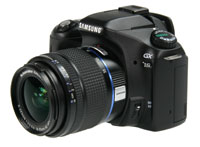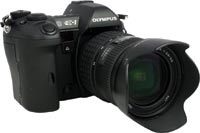A new flagship model in Canon’s entry-level DSLR line-up offers improved autofocusing plus new functions that make it easier to obtain good photos and movies.


A new flagship model in Canon’s entry-level DSLR line-up offers improved autofocusing plus new functions that make it easier to obtain good photos and movies.

We update our First Look at the EOS 5D Mark III with a user report plus a full suite of test results and sample images.

An upgrade to the EOS 5D Mark II with a new image processor, inbuilt HDR processing and similar AF and video facilities to the EOS-1D X

The long-awaited replacement for the EOS 5D offers higher resolution plus Full HD video capture.Serious photo enthusiasts have been well catered for in the latest releases from Canon, Nikon and Sony but Canon’s EOS 5D Mark II is probably the most eagerly-awaited of the new models, largely because its predecessor was so successful. Interestingly, the body design of the new model has changed very little from the original 5D. This will please many users, since most controls are in familiar locations and the general look and feel of the new camera is essentially unchanged.

A competitively priced DSLR with all of the controls needed by amateur photographers.Samsung’s first DSLR camera, the GX-1S, reflects its mixed ancestry in a body that appears almost identical to Pentax *ist DS2, and has remarkably similar specifications. Although compatible with most Pentax KAF mount lenses, the GX-1S is being supplied with a Schneider Kreuznach D-Xenon 18-55mm f/3.5-5.6 lens, which has been specially developed for the new camera. Its light weight (225 g) is a comfortable match for the camera body, but rather a snug fit on the camera body. It comes with a clip-on lens hood.

[ia] Although not the most compact DSLR available, the Pentax *ist DS is the smallest and lightest in the 6.1-megapixel category and keenly priced for its category. Sporting a tough, stainless-steel chassis and sophisticated electronics, the *ist DS combines the controls photographers want with plenty of user-friendly features, making it a good choice for any photographer who wants an affordable, high-performing camera. It will be especially attractive to those with Pentax K, KA, KAF, and KAF2 lenses, most of which can be used with the *ist DS body.

Smaller and lighter than its main competitors, the Pentax *istD features the same 6.1-megapixel CCD as the Nikon D70 and Konica Minolta Dynax 7D. Features include a pop-up flash with five selectable modes but no flash output adjustment (one of the *ist D’s few major omissions). A hot-shoe is provided for optional external flash units. The viewfinder is large, bright and informative and the 1.8-inch LCD monitor is backlit for improved viewing. Focusing is fast and accurate with most subject types and focus area selection is provided, with 11 selectable points. Over- and under-exposure warnings are also provided in manual mode. These warnings are duplicated on the top LCD panel as blinking shutter speed and aperture displays.

The first ‘consumer’ DSLR for the Four Thirds camera format.

Notable performance aspects of the E-1 were its focusing speed and accuracy and the spot meter’s accuracy was equally impressive. The white balance control performed well under a variety of lighting conditions. Image quality in bright lighting was very good and the test lens delivered full edge-to-edge sharpness but noise was obvious at high ISO settings.

With no higher-resolution sensor available, Nikon has opted to improve the features and functionality of its popular D70 model. Fortunately, until the next generation of ‘pro-sumer’ DSLR cameras arrives, the new D70s model will make many potential buyers very happy. For starters, for the $1999 price tag you now get a high-quality AF-S Nikkor 18-70mm lens as well as the improved camera body.
Ads can be a pain, but they are our only way to maintain the server. Please deactive Ads blocker to read the content. Your co-operation is highly appreciated and we hope our service can be worth it.